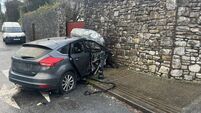Locked up and forgotten in Mountjoy

The last one in was a young man who had been moved downstairs as he was fearful of his personal safety in the packed prison.Another was a man who had, just days earlier, frightened a senior psychiatrist because he was so violent and deluded.
Crucially, he had not been given his anti-psychotic medication.A considerable amount of alcohol was consumed through the night. At 6.30am, six of the prisoners filed out of Holding Cell 2. They quietly informed prison officers that one man was still inside under a pile of duvets, with a sheet covering his face.He was pronounced dead an hour later.
Eight years on, a Commission of Investigation report has found that the regime in Mountjoy at the time was “inept, dysfunctional, and showed reckless disregard for the safety needs of both prisoners and staff”.As a result, Gary Douch is dead.
Stephen Egan, who has deep psychiatric problems, is serving a life sentence for his manslaughter.

Gary Douch had celebrated his 21th birthday in Portlaoise Prison and the next day, July 24, 2006, he was transferred to Mountjoy.
He had already spent most of his adult life behind bars, having been convicted in July 2005 for assault causing harm, with his sentence backdated to his committal a year earlier.
The second youngest in a family of eight, he had been given a three-year sentence. The severity of the sentence reflected teenage years which had seen the boy from Coolock amass convictions for theft, drug use, and assault.
When he was moved to Mountjoy, he was placed on C Wing. At the time, there were more than 520 prisoners in a facility that was supposed to cater for less than 470. On C Wing, he was left sharing a cell with 17 other inmates but he felt afraid that he was going to be attacked.
He spoke to a prison officer and asked for protection. Eventually, he was transferred to a holding cell in the basement of the prison. But the investigator said the overcrowding in Mountjoy completely undermined the ability of the prison to respond in a safe way to his request for protection.
The conditions he was placed in “created an unquantifiable and unacceptable safety and security risk”.
This cell was the space used to house vulnerable people on the night, including an inmate who had been stabbed in the prison yard earlier in the day.
At one stage that evening, 14 prisoners were in the cell. As it approached nighttime, seven men were taken out and the remainder were given bed clothes to sleep with.
Just after 4am the toilet light was turned on. The investigator said this was possibly done by Gary Douch.
He had somehow taken on a considerable amount of alcohol during the night.
At 6.30am, he was found badly beaten under a pile of bed clothes.
He underwent CPR for 20 minutes and was taken to the Mater Hospital, across the road, where he was pronounced dead.
It was not the first time the State failed Gary Douch. He was first charged with a minor offence in early 1997 and it was recommended that he be placed in a special care centre, but there was no vacancy for him.

Stephen Egan was born in 1983 and first appeared before the Children’s Court when he was aged 15.
For three years up to 2003, Egan spent most of his time in St Patrick’s Institution, but also had stays in Wheatfield and on Spike Island.
After leaving St Patrick’s, he shifted between prison cells for the next two years, getting moved through institutions at least 17 times.
There were frequent reports of violent behaviour towards officers and inmates. His record showed 90 different written disciplinary reports.
Portlaoise asked a doctor to see him in March 2005 but there was no evidence that this was followed up.
In November 2005, he seriously assaulted a prison officer during a transfer by attempting to choke her with his handcuffs.
During the next month, he was transferred out of Cloverhill for security reasons. He was put in a secure cell at his own request, which he set fire to after claiming to have had hallucinations.
However,, despite behaviour which the investigator said was “bizarre” there was no record of a psychiatrist going to see him in Cloverhill.
Egan was moved back and forth between Mountjoy and Cloverhill as both facilities struggled to meet his needs.
In February 2006, he was reviewed by a psychiatrist and prescribed anti-depressants and anti-psychotic medication.
It was recommended that he have further follow-ups, yet there is no record that he was checked by any medical professional until four months later, when he was seen by a GP. He set fire to another cell and flooded his replacement accommodation three days later.
The Prison Service sent him to Portlaoise as punishment and when he returned he was put in an observation cell.
On July 5, 2006, he was sent to the Central Mental Hospital, where a psychiatrist found him to be “acutely psychotic”. He reported visions of “the Beast”.
Less than 10 days later, he was deemed fit to return to prison.
Egan was sent back to Cloverhill, because those treating him had been adamant his release was conditional on him not returning to Mountjoy.
He was not medically assessed on returning to Cloverhill and was not seen by mental health professionals as often as he should have been.
On July 26, he was interviewed by an external senior clinical psychologist who had no prior knowledge of his violent past, his mental health problems, or that he had just been released from the Central Mental Hospital.
In the interview room, this professional began to feel scared for his own personal safety and described Egan as “manic”, “completely deluded”, and “very unwell”. These concerns were not communicated to the in-reach psychiatric service in Cloverhill and they only became aware of it when the Commission of Investigation told them in 2010.
On July 29, Mountjoy was overcrowded, so it was willing to exchange five prisoners for Egan. None of the psychiatric staff were notified and Mountjoy was not informed about his recent assessments.
Back in Mountjoy, he was placed in an observation cell which at one point on July 31 was holding 31 people.
The prison officers were not told about Egan's particular needs or his recent history. They could not have known that he was displaying the same evidence of episodes as he had shown in the Central Mental Hospital.
Between 4am and 6.30am, he beat Gary Douch on his arms, legs, and face before burying him under a pile of bedclothes.















